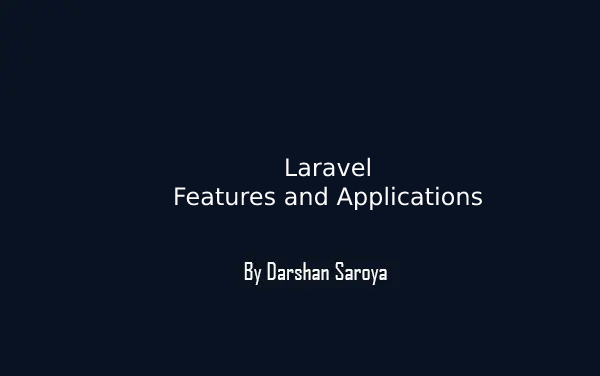Laravel is a free, open-source PHP web application framework that was first introduced in 2011. Since then, it has grown in popularity and is now considered one of the most popular PHP frameworks worldwide. Laravel provides developers with an easy-to-use and efficient toolset for building complex, modern web applications.
In this article, we will discuss the key features of Laravel and its various applications.
Table of Contents
Laravel Features
MVC Architecture
One of the most significant features of Laravel is its Model-View-Controller (MVC) architecture. This architecture separates the presentation layer from the business logic, making it easier to maintain and test code. Laravel’s MVC structure provides a clear separation of concerns, which means that developers can focus on their respective areas without interfering with others.
Artisan Command-Line Interface
Laravel has a powerful command-line interface (CLI) called Artisan. Artisan provides developers with a set of pre-defined commands that can be used to automate repetitive tasks. These commands can be used to generate boilerplate code, manage database migrations, and much more.
Blade Templating Engine
The blade is Laravel’s templating engine, which is designed to make it easier for developers to create reusable and efficient templates. Blade templates are lightweight and easy to read, making them an excellent choice for web applications with complex user interfaces.
Eloquent ORM
Laravel’s Eloquent ORM (Object-Relational Mapping) allows developers to work with databases using an object-oriented syntax instead of SQL queries. This makes it easier to manage and manipulate data and also helps to prevent common SQL injection vulnerabilities.
Authentication
Laravel provides an out-of-the-box authentication system that can be easily configured to secure web applications. The authentication system provides features like user registration, login, and password reset. It also includes support for two-factor authentication, which is an essential security feature for many applications.
Laravel’s documentation is available in over 20 languages, which reflects the framework’s global reach and popularity. Laravel is used by many large companies and organizations, including IBM, Cisco, and BBC.
Applications of Laravel
E-commerce Websites
Laravel is an excellent choice for building e-commerce websites. Laravel’s built-in features like MVC architecture, Eloquent ORM, and Artisan CLI make it easy to develop and maintain complex e-commerce websites.
Content Management Systems (CMS)
Laravel is also a great choice for building CMS systems. Laravel’s Blade templating engine makes it easy to create reusable and efficient templates, while its Eloquent ORM allows developers to work with databases using an object-oriented syntax.
Social Networks
Laravel can be used to build social networks and online communities. Laravel’s MVC architecture makes it easy to create and maintain complex web applications, while its authentication system provides security features like user registration, login, and password reset.
APIs
Laravel is a popular choice for building APIs. Laravel’s built-in features like Eloquent ORM and Artisan CLI make it easy to develop and maintain APIs, while its Blade templating engine can be used to render JSON responses.
Conclusion
Laravel is a versatile and powerful PHP framework that can be used to develop a wide range of web applications. Its key features like MVC architecture, Artisan CLI, Blade templating engine, Eloquent ORM, and authentication system make it an excellent choice for building complex and modern web applications. Whether you’re building an e-commerce website, a CMS, a social network, or an API, Laravel has the tools you need to get the job done.




Leave Your Comment Here